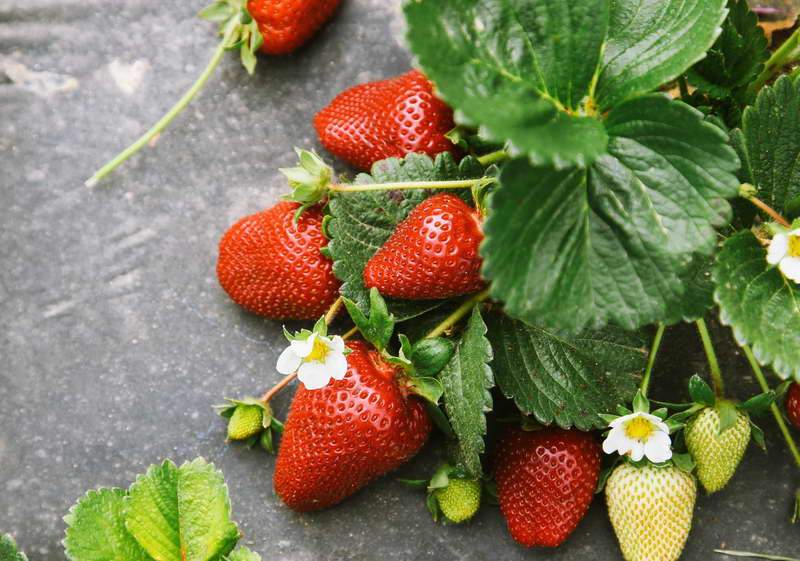
A prerequisite for obtaining a rich strawberry crop is the proper preparation of the beds and soil for planting. At the same time, it is important not to miscalculate the timing of planting work, as well as to provide strawberries with proper care.
Content
Choosing the best place to land
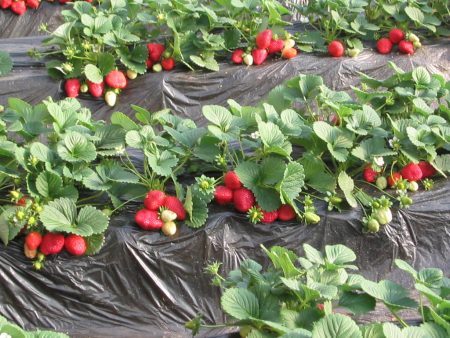
Strawberries are a very demanding crop. The berry growing area should have the following characteristics:
- be flat or have a slight slope;
- well lit by the sun during most of the day;
- located in the southwest of the site;
- to be high, without long stagnation of moisture.
Strawberries will not grow and bear fruit well when planting in lowlands and in areas flooded in spring. When placing berry beds in the shade or partial shade, the quantity and quality of the crop suffers: the berries are noticeably smaller, the taste becomes sour. Planting in places with groundwater above 60 cm from the soil surface threatens strawberries with frequent lesions of fungal diseases. The northwestern part of the plot is also unfavorable for strawberry cultivation.
Crop rotation rules and selection of neighbors for strawberries
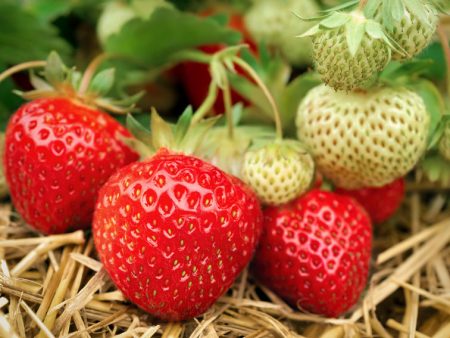
When choosing a place for planting, one should not neglect such an important agricultural technique as crop rotation. A well-planned alternation of crops allows you to get abundant harvests of berries annually. The best predecessors for strawberries:
- siderates (rapeseed, mustard, buckwheat);
- greenery;
- legumes;
- onion;
- garlic;
- carrot;
- radish, radish.
Plants after which it is not recommended to plant strawberries:
- all nightshade;
- cabbage;
- cucumbers, zucchini;
- pumpkin, Jerusalem artichoke.
As for the plants - neighbors, then strawberries can not be attributed to particularly capricious in this regard, it is friends with many cultures. Especially comfortable berry bushes will grow next to:
- flower beds: with velvet and nasturtiums;
- herbs (basil, sage);
- greens (salad, spinach, sorrel);
- garlic and onion.
Not too pleasant "company" for strawberries will be nightshade. They quickly pull out all the useful substances from the soil, and they are also the distributors of late blight. It is dangerous to place berry beds near raspberries and rose hips. Pests of these crops quickly spread to strawberry bushes. There will be no good harvest in the neighborhood of cabbage, as it claims to the same nutrients and requires more frequent watering.
You should know!
Agronomists recommend updating the berry every three to four years. After this period, yields are markedly reduced, plants are increasingly affected by various diseases, and are also attacked by pests.
Soil preparation
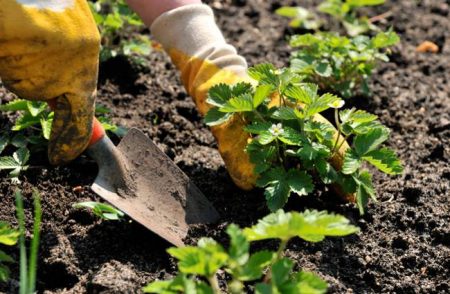
Suitable for berry culture will be light in composition soil, which does not accumulate moisture. Such properties are characteristic of loamy and sandy loamy soils. On soils with a different composition, the situation can be corrected by introducing additional components:
- coarse river sand in the amount of 2-3 buckets per 1 m2 - on heavy and clay soils;
- humus in the amount of 2-3 buckets per 1 m2 - on light, sandy soils.
To increase fertility in all areas except chernozem, additionally on 1 m2 it is necessary to introduce the following components:
- humus - 1 bucket;
- superphosphate - 2 matchboxes;
- potassium sulfate - 1 tablespoon.
Distribute the substances evenly over the surface of the plot, dig over the soil and leave to rest for 14-20 days. During this time, the soil will settle, and the fertilizers will completely dissolve and take on a form easily digestible for strawberries.
Important for berry bushes and soil characteristics such as acidity. Soil with a slightly acidic reaction, that is, with a pH of about 5.5-6.0, will be ideal. To make acid soil suitable for planting, a liming procedure is carried out. To do this, use dolomite flour or fluffy lime.
Application rates for various types of soil
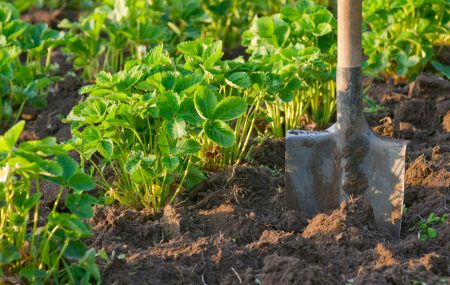
| Soil type | Dosage per 1 m2 | Substance action period |
| Light sand and sandy loam | 150-200 grams | 2-3 years |
| Heavy clay and loamy | 500-700 grams | 10-12 years old |
Liming is carried out 4-6 months before planting, because freshly soiled soil negatively affects the state of strawberry roots.
Advice!
To determine the acidity of the soil, you can use the litmus indicator strips, widely available on sale. From improvised means for this purpose, you can use table vinegar. On the surface of the investigated land you need to drip with acetic acid. The reaction in the form of small bubbles means that the soil has a neutral acidity. In the absence of reaction, we can conclude that the soil on the site is acidified.
How to prepare beds for planting strawberries in August
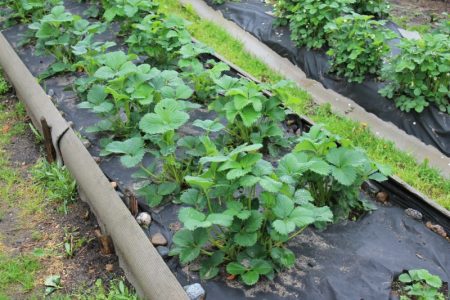
Depending on the characteristics of the plot and the desire of the gardener, strawberries can be grown in different beds according to the method of formation. Each design method has its own advantages and features.
A simple way to land
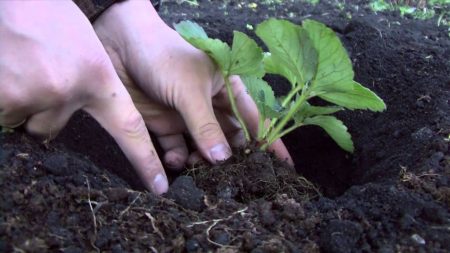
The landing method “out of the blue” is suitable for high and dry areas. Landing holes are placed in one or two rows. In the first case, the row-spacings are left with a width of 65-70 cm. With a two-line pattern, planting between the rows is 80 cm wide and the row spacing is 40 cm. The distance between the bushes is determined depending on the varietal characteristics of the strawberries.
Regardless of the planting pattern between the rows, it is necessary to dig dividing grooves with a depth of about 15-20 cm. Such furrows are necessary to collect excess rainwater. This will significantly reduce the risks of the spread of diseases and pests.
Low bulk German bed under strawberries
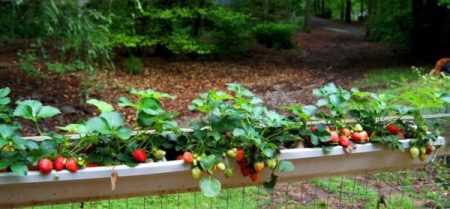
The German garden is an embankment framed by sides of boards or other material. This option is great for lowlands and wetlands. The height of the sides depends on the desire of the gardener, on average it is 20-25 cm.
The plot under the bed must be cleaned of weeds and remove the upper fertile layer. After installing the box on the prepared place, they begin to fill it in the following order:
- protective net from rodents;
- drainage layer (broken brick, dry branches, expanded clay);
- nutritious soil.
The width of the ridges can be different, but in order to make it convenient to care for plantings, it should not exceed 80 cm. The planting pattern in such ridges can be either single-row or double-row.
Growing strawberries in German beds has several advantages:
- convenient to care for plants;
- the soil is not washed away by rains;
- weeds cannot move from one bed to another;
- drainage provides good soil aeration, which significantly increases productivity and reduces the risks of the spread of fungal diseases;
- give the site an aesthetically attractive look.
Advice!
For the "German" beds to last for several years, carefully treat the boards with special antiseptic agents.
High barrels or tire beds
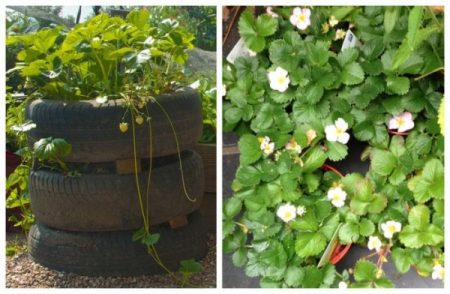
For the design of such ridges, wooden or plastic barrels, as well as tires from different cars, are suitable. Ideal tires from combines, VAZ and MAZ vehicles. Tanks should be dug a little into the ground and filled with fertile soil. To increase the usable area of the tires, the inside is cut out. To give future beds aesthetics, you can paint the tires.
Such beds have many advantages:
- it is convenient to carry out agricultural work (no need to stoop low);
- durability;
- compactness and mobility (can be moved);
- lack of material costs.
The only drawback when choosing such ridges will be a small amount of landings, even only 5-6 berry bushes will fit in the largest tire.
Agrofibre landing
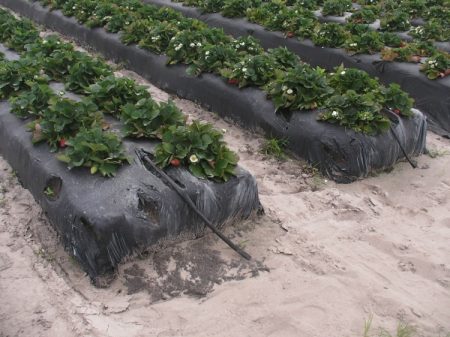
The most common way to plant strawberries among gardeners. It is possible to use agrofibre both on a usual bulk bed, and on a bed of the "German" type. And in that, and in another case, it is necessary to carefully dig the soil and make the necessary fertilizers. Then, spread the canvas over the soil and fix it with wire studs.
The canvas is available in standard sizes, 1.6 m or 3.2 m wide. This should be taken into account when planning the length and width of the beds to avoid joints. Landing holes in agrofibre, as a rule, are already available. If you purchased a solid agricultural canvas, then markup in accordance with the desired landing pattern. In the designated places, cut the fabric crosswise with a sharp knife, take the corners out. Plant strawberries in the resulting holes.
The use of agrofibre has several advantages:
- the material perfectly passes moisture and air, but does not allow weeds to germinate;
- berries do not have contact with the ground;
- the crop ripens 1-2 weeks earlier, due to the rapid heating of the soil in the spring;
- excellent aeration is ensured (the soil surface does not dry out and a crust does not form).
Decorative vertical beds
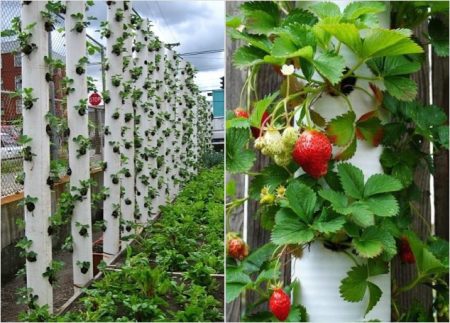
Vertical designs for planting strawberries are very popular among owners of small garden plots. The most common landing methods:
- wooden bed pyramid
Such a design is made of several tiers of square wooden boxes. The sizes of the boxes can be different, but each tier should be 30-35 cm smaller than the previous one. First, prepare the desired number of boxes. Then, starting with the larger, set them on top of each other, filling each with fertile soil. The bed can have from three to nine tiers.
- into metal or plastic pipes
Pipes with a diameter of at least 15 cm are suitable. Over the entire height of the pipes, it is necessary to cut holes in a checkerboard pattern at a distance of about 20 cm. It is best to concrete the pipe in soil or attach it in several places to a support, for example, to a veranda or arbor. Fill the established structure with nutritious soil mixture and plant strawberries.
- in plastic bottles
Cut plastic bottles, fill with soil and secure with ropes on any vertical surface. One bottle contains one bush.
Advantages of vertical beds:
- save space;
- decorate the site;
- contact of berries with soil is excluded;
- simplicity in leaving (lack of weeds).
You should know!
The soil in vertical beds dries very quickly, so watering must be done every 2-3 days.
General Strawberry Planting Tips
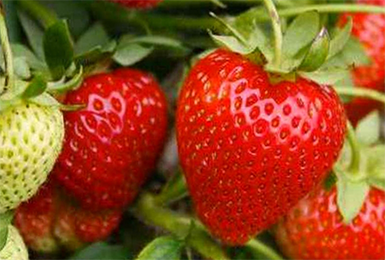
Regardless of which method of designing the ridges you choose to get a good and high-quality crop, you need to know some features of the care and cultivation of this crop.
When to plant
For planting strawberry bushes, both spring and autumn season are suitable. Saplings grown independently from seeds are transplanted into the ground in May-June.The guideline is to establish an average daily temperature of 15 degrees heat.
When propagating strawberries with a mustache, planting can be made from early August to mid-October. It is important to complete the planting work a month before the first night frosts. Agronomists consider August the best month for planting strawberries. Plants planted at this time have time to grow stronger and practically do not freeze in winter. Harvest from such beds will be available next year.
The choice of planting material. What mustache to take for landing
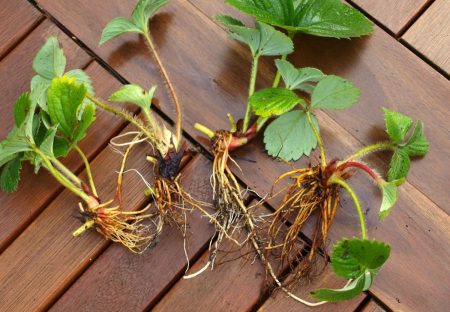
For reproduction use a mustache from healthy and bringing excellent yields of bushes. In order for children to be stronger from early spring, maternal bushes should be cut off all peduncles. The very first sockets in terms of location from the "mother" have a more developed root system, so they are considered the best planting material. The remaining shoots are not suitable for further reproduction, so they are removed.
Outlets can be dug next to mother bushes or planted in separate pots. After the children grow up a little, and can feed moisture from the soil, they are independently separated from adult bushes and transplanted to a new place.
Is it possible to plant different varieties of strawberries nearby
Planting different varieties of strawberries on the same bed is quite acceptable. Since strawberry is an overgrown receptacle, not a fruit, there is no need to be afraid of pollinating varieties. Confusion in an overgrown mustache is the only drawback of mixed landings.
Experienced gardeners advise sharing adjacent varieties with several rows of garlic or onions. Well as a separator fit pieces of slate dug in a bed between the bushes.
Care for berry beds
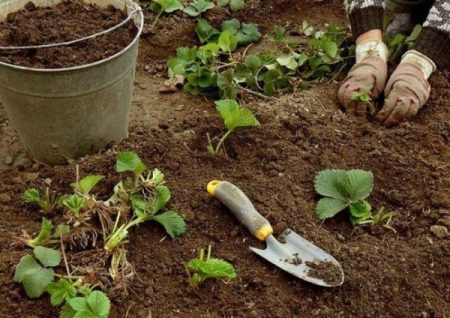
In order to receive good yields of berry beds every year, it is necessary to ensure proper care. It consists of the following agricultural techniques:
- Watering
Berry irrigation is carried out based on weather conditions. In a dry summer, watering is carried out 1-2 times a week. With regular rainfall, watering can be reduced or stopped altogether.
- Mulching
In order to preserve moisture in the soil as long as possible, a mulching layer is lined on the beds. As mulch, you can use straw, agrofiber, cardboard. The coating is lined between berry bushes in early spring, immediately after the snow melts. In anticipation of the winter season, the mulch layer is replaced with a new - dried humus.
Spring mulch prevents the growth of weeds, maintains good aeration of the soil and excludes contact of berries with the ground. Winter cover will protect the roots of strawberries from freezing and additionally fertilize the soil.
- Top dressing
Fertilize the berry from the second year after planting. Agronomists recommend feeding the crop according to the following scheme:
- in early spring - make nitrogen-containing fertilizers;
- during the formation of buds - apply potassium nitrate;
- in the autumn period - use phosphorus-potash fertilizers.
Advice
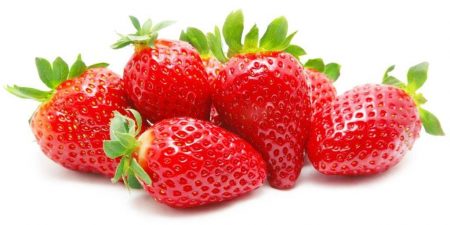
And finally, we will give some more tips to get a new bigger crop every year:
- the berries will be larger and sweeter if the beds are arranged in a sunny place from east to west;
- renew planting every four years (with the exception of some varieties that can perfectly bear fruit for a longer time in one place);
- if your garden plot is located on a slope, then place a berry bed across it, so the plantings will not be eroded by precipitation;
- in order to destroy slugs, caterpillars and other insect pests living in the soil, treat the area immediately before planting with ammonia solution (3 tablespoons per bucket of water).
Having familiarized themselves with the main options for the formation of strawberry ridges and the rules for caring for them, even the most inexperienced gardener will be able to plant strawberries on his plot and enjoy berries every summer season.

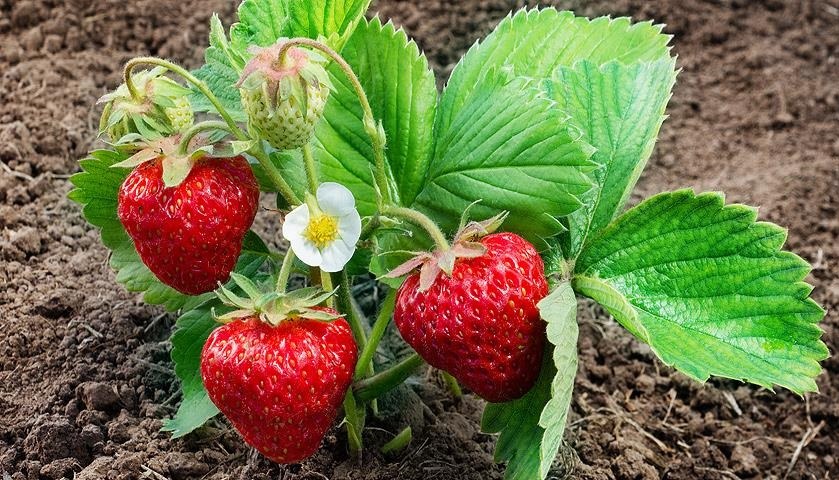
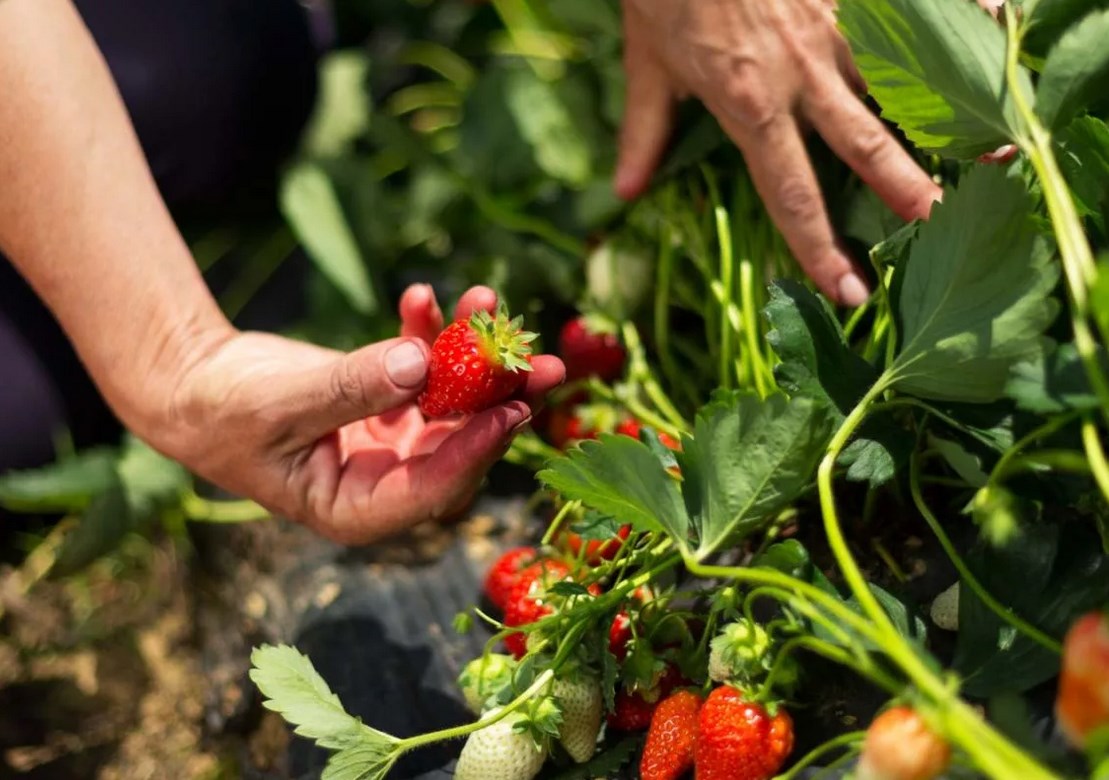
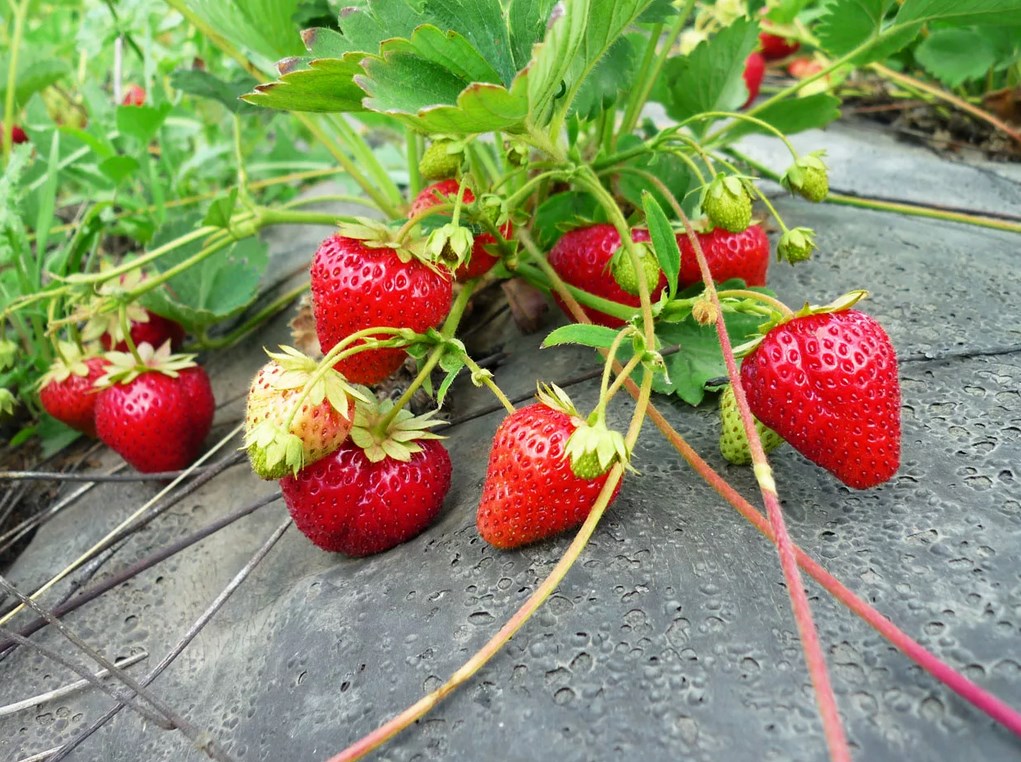
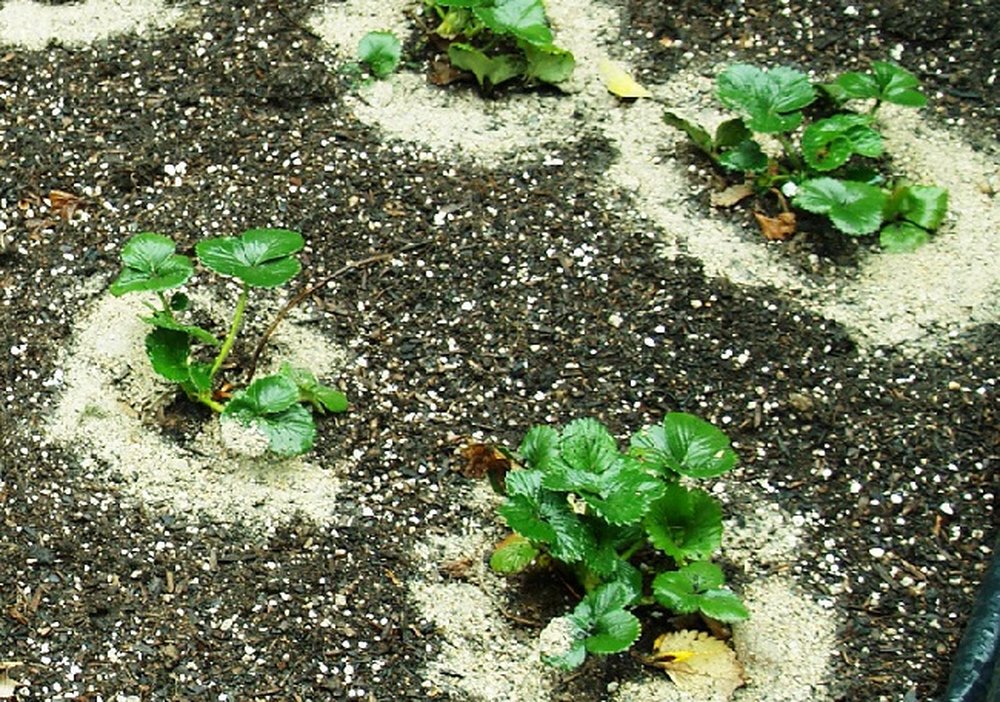 When to plant strawberries for seedlings from seeds in 2024
When to plant strawberries for seedlings from seeds in 2024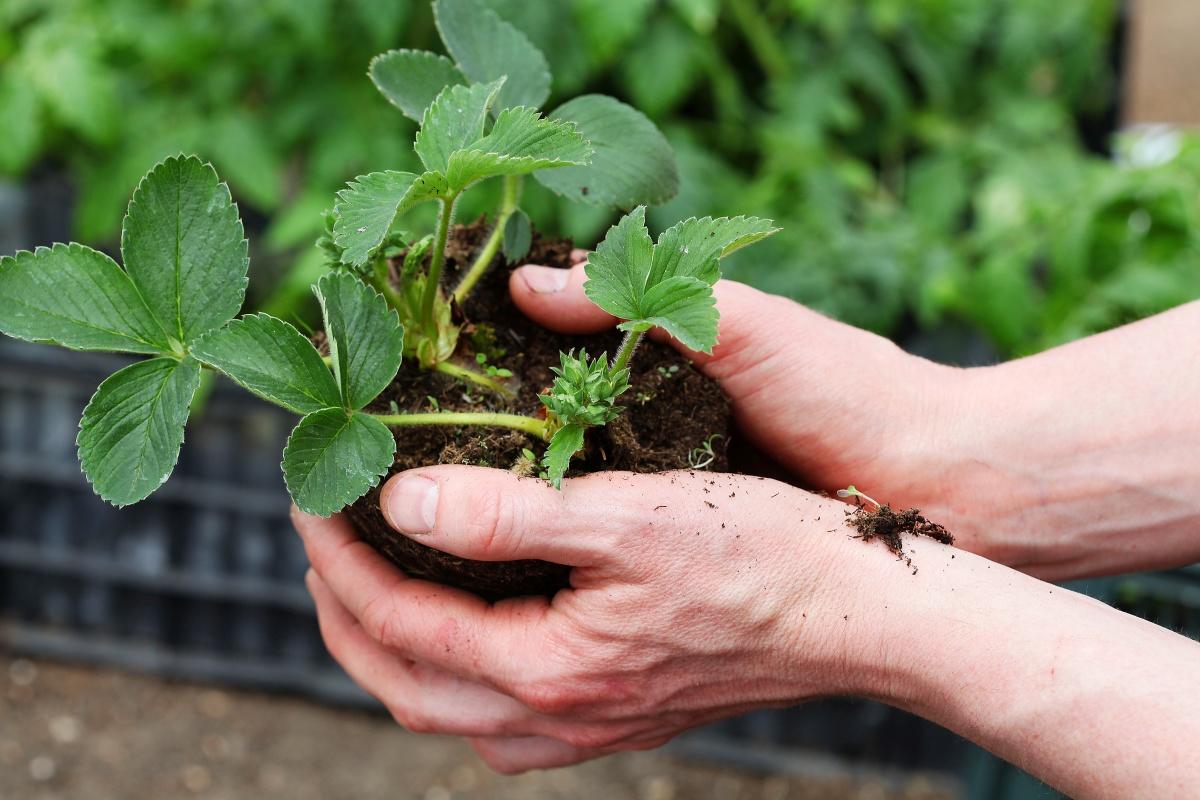 What month is better to choose for a strawberry transplant in autumn
What month is better to choose for a strawberry transplant in autumn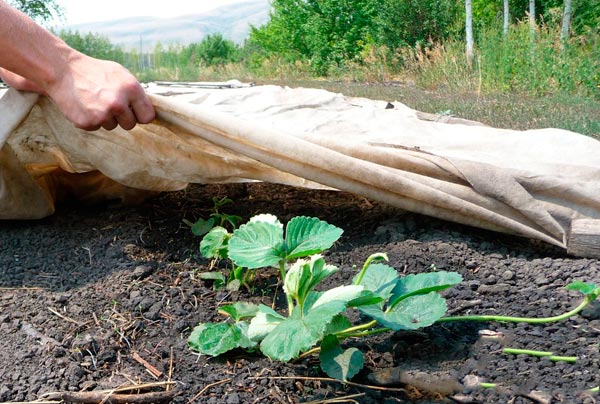 How to cover strawberries for the winter
How to cover strawberries for the winter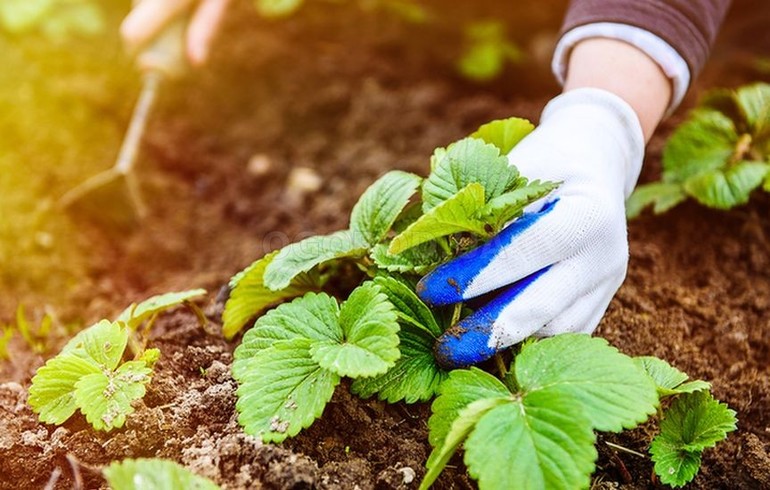 Proper care and pruning strawberries in the fall in the suburbs
Proper care and pruning strawberries in the fall in the suburbs